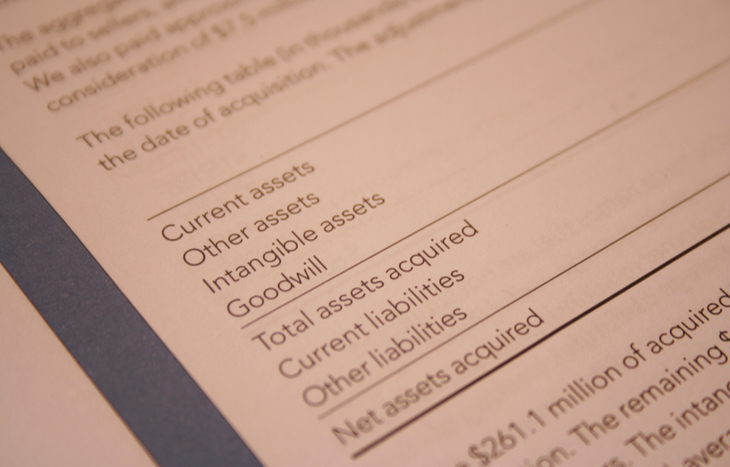What is Goodwill in Accounting?

When you feel good about something, you’re usually willing to pay more for it. It’s the same concept when a company considers acquiring another. As a result, acquiring companies are often willing to pay a premium on the transaction. That extra is known as goodwill in accounting: the excess amount paid over the net worth of the acquired company.
Goodwill tends to represent the intangible, long-term assets from the acquisition of one company by another. The company’s brand-name best-selling products or its lengthy library of intellectual property. Whether that goodwill will actually amount to the premium paid for it is what many companies find themselves asking long after the transaction is complete.

How to Calculate Goodwill in Accounting
Calculating goodwill is tricky, since intangibles aren’t easily valued. It comes down to assessing fair market value based on the assets and liabilities of the company getting acquired. The formula is simple, yet involved:
Goodwill = P – (A – L)
- P = Purchase price of the target company
- A = Fair market value of assets
- L = Fair market value of liabilities
It’s important to note that the value of goodwill can change depending on when it’s assessed. If a company has strong investor sentiment behind it, goodwill might be high. If the company is struggling, goodwill valuation might be low. Regardless, it’s almost always assessed at a premium.
Examples of Goodwill
Goodwill is anything with intangible value that the company can claim as an asset during an acquisition. Any number of intangibles may constitute goodwill; some of the most common include:
- Intellectual property. Trademarks, patents and similar intangible, deployable assets.
- Brand recognition. The clout a brand or business has over competitors in the market.
- Company reputation. The positive sentiment affiliated with a company or brand.
Many times, goodwill can represent a substantial sum. For example, a company like Coca-Cola (NYSE: KO) has a significant amount of brand recognition associated with it. Likewise, a company like the Walt Disney Company (NYSE: DIS) has thousands of intellectual property holdings.
These are both examples of assets, since they ultimately contribute to the companies’ ability to generate revenue. If they were the subjects of acquisition, their goodwill would be substantial, commanding a much higher premium.
Acquisition
Goodwill tends to show up on a balance sheet after an acquisition as the premium one company pays for another. For example, software giant Salesforce.com (NYSE: CRM) acquired messaging startup Slack in 2020, paying more than 10% above Slack’s most recent high valuation and more than 60% above its market cap at the time. This premium represents goodwill.
Write-Downs
When a company overpays for an acquisition or the deal flounders, it may result in a write-down of goodwill. For example, in 2019 Kraft Heinz Co. (NASDAQ: KHC) made headlines when it recorded a $7.3 billion goodwill impairment—the largest in more than a decade. The write-down effectively represents a reevaluation of the market value of the intangible asset in accordance with Generally Accepted Accounting Principles (GAAP).
Other Intangibles
It’s important to realize that goodwill is separate from other intangibles in that it specifically associated with acquisition.
What Does Goodwill Tell Investors?
When it comes to acquisition, goodwill represents the acquirer’s confidence in the company or asset they’re buying. For example, if ABC Company has a valuation of $20B and XYZ Company acquires it for $22B, it means XYZ Company believes it’s worth that much—or will be soon. Often, this premium is represented against the target company’s book value.
Goodwill can also tell investors a lot about the performance of a company’s intangible assets. For example, if a company claims a goodwill impairment on a brand under its umbrella, it clues investors in that the impaired brand isn’t performing well. This, in turn, provides further context for other financial data on the income statement or balance sheet.
The Problem With Impairment and Write-Downs
Goodwill is inherently an amount over fair market price. That means it’s subject to a write-down if it doesn’t meet that premium within a certain amount of time. However, goodwill write-downs are often subject to controversy. They involve many intangible, unprovable valuations and are forward-looking. This makes it very easy to over-estimate goodwill—a situation that leads to a goodwill impairment.
Goodwill impairment occurs when the value of an intangible asset drops below its historical cost. Effectively, it means the cost paid to acquire the asset wasn’t worth it. Companies need to prove this through either the income approach and the market approach to asset valuation. The net difference of the new value is the impairment and the write-down amount.
Write-downs can cause the company’s value to fall based on a fair market reassessment of the goodwill. It’s a situation that impacts shareholders and creates irregularities in financial reporting. And while write-downs are common and often relatively innocuous, large write-downs or those occurring long after the acquisition tend to draw ire from investors.
Goodwill Represents a Tricky Concept
Intangible assets are hard to evaluate—even more so in a volatile market. For many companies, goodwill isn’t just what they think an acquisition target is worth: it’s the premium they need to pay to beat out competitors. It becomes paradoxical: a company pays above fair market value to acquire an asset that it could later reassess at a lower value closer to what it’s actually worth.
Of course, not all goodwill acquisitions end in a write-down. Many end in substantial cash flows for the acquiring company. They capitalize on the intellectual property, sterling reputation or brand recognition of the acquirer, and use them to strengthen revenues. After all, that’s the point of an acquisition. To advance your investment education further, sign up for the Investment U e-letter below. These daily newsletters provide stock tips, financial insights and much more!






